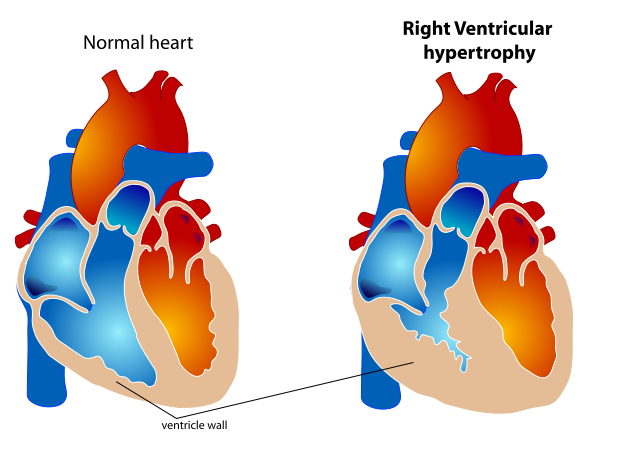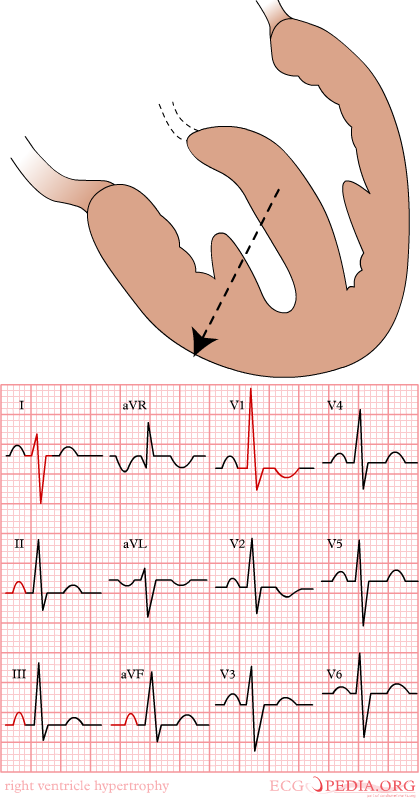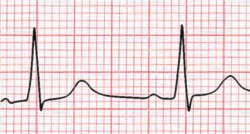Right ventricular hypertrophy: Difference between revisions
Jump to navigation
Jump to search
Ochuko Ajari (talk | contribs) |
Ochuko Ajari (talk | contribs) |
||
| Line 17: | Line 17: | ||
==Causes of Right Ventricular Hypertrophy== | ==Causes of Right Ventricular Hypertrophy== | ||
===Life Threatening Causes=== | ===Life Threatening Causes=== | ||
Life-threatening causes include conditions which may result in death or permanent disability within 24 hours if left untreated. | |||
===Common Causes=== | ===Common Causes=== | ||
Revision as of 18:04, 4 May 2014
| Right ventricular hypertrophy | |
 | |
|---|---|
| Right Ventricular hypertrophy |
Editor-In-Chief: C. Michael Gibson, M.S., M.D. [1]
Synonyms and keywords: RVH, RV strain
Overview
Right ventricular hypertrophy is a form of ventricular hypertrophy affecting the right ventricle.
Pathophysiology
Blood travels through the right ventricle to the lungs. If conditions occur which decrease pulmonary circulation, meaning blood does not flow well from the heart to the lungs, extra stress can be placed on the right ventricle. This can lead to right ventricular hypertrophy.
Causes of Right Ventricular Hypertrophy
Life Threatening Causes
Life-threatening causes include conditions which may result in death or permanent disability within 24 hours if left untreated.
Common Causes
Causes by Organ System
Causes in Alphabetical Order
- Atrial septal defect
- Bronchiectasis
- Cardiac fibrosis
- Chronic Obstructive Pulmonary Disease (COPD)
- Churg-Strauss syndrome
- Coal worker pneumoconiosis
- Cor pulmonale
- Cystic fibrosis
- Eisenmenger's Syndrome
- High altitude[1]
- Left ventricular hypertrophy or dilation
- Mitral stenosis
- Obstructive sleep apnea
- Pickwickian Syndrome
- Primary pulmonary hypertension
- Pulmonary embolism
- Pulmonary fibrosis
- Pulmonary hypertension
- Pulmonic regurgitation
- Pulmonic stenosis
- Scoliosis
- Tetralogy of Fallot
- Transposition of the Great Vessels
- Tricuspid regurgitation
- Ventricular septal defect
Diagnosis
EKG Findings in Right Ventricular Hypertrophy

Shown below is a tracing from lead V1 which shows right ventricular hypertrohpy, with an R wave > the S wave in V1

Diagnostic Criteria for Right Ventricular Hypertrophy
- Right axis deviation of +90 degrees or more
- RV1 = 7 mm or more
- RV1 + SV5 or SV6 = 10 mm or more
- R/S ratio in V1 = 1.0 or more
- S/R ratio in V6 = 1.0 or more
- Late intrinsicoid deflection in V1 (0.035+)
- Incomplete RBBB pattern
- ST T strain pattern in 2,3,aVF
- P pulmonale or Right atrial enlargement or P congenitale
- S1 S2 S3 pattern in children
- Tall R wave in V1 or qR in V1
- R wave greater than S wave in V1
- R wave progression reversal
- Inverted T wave in the anterior precordial leads
Differential Diagnosis of R>S in V1
- RVH
- Posterior MI
- WPW
- HCM (septal hypertrophy)
- Kulbertus' block (septal fascicular block)
- Duchennes Muscular Dystrophy
- Normal variant
- V4r may be a more useful and reliable than lead V1 in that it often reveals an r>s while v1 remains normal
- An incomplete right bundle branch block in the right precordial chest leads may signal the development of RVH
- In the limb leads right axis deviation develops and at times prominent Q waves simulating an IMI appear in leads 2,3, and aVF.
- In children an S1 S2 S3 pattern (i.e. an S wave deeper than R in all 3 standard leads) is a reliable index of RVH
- RV strain can be seen in leads V1 and V2 but also in leads 2,3, aVF